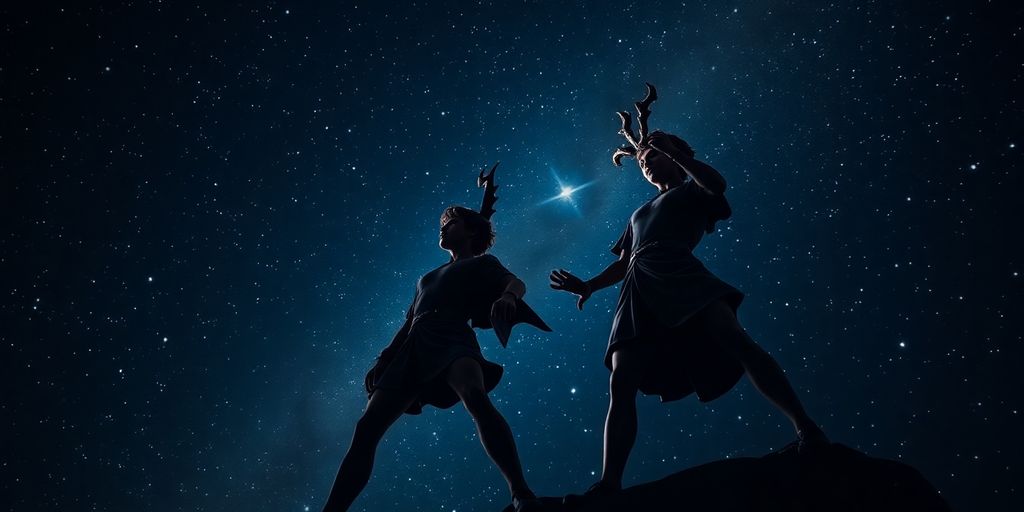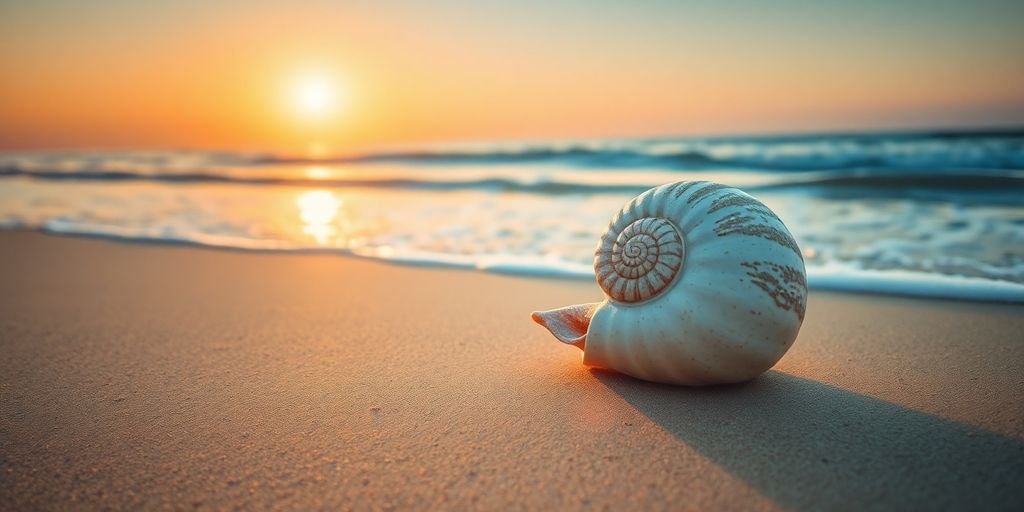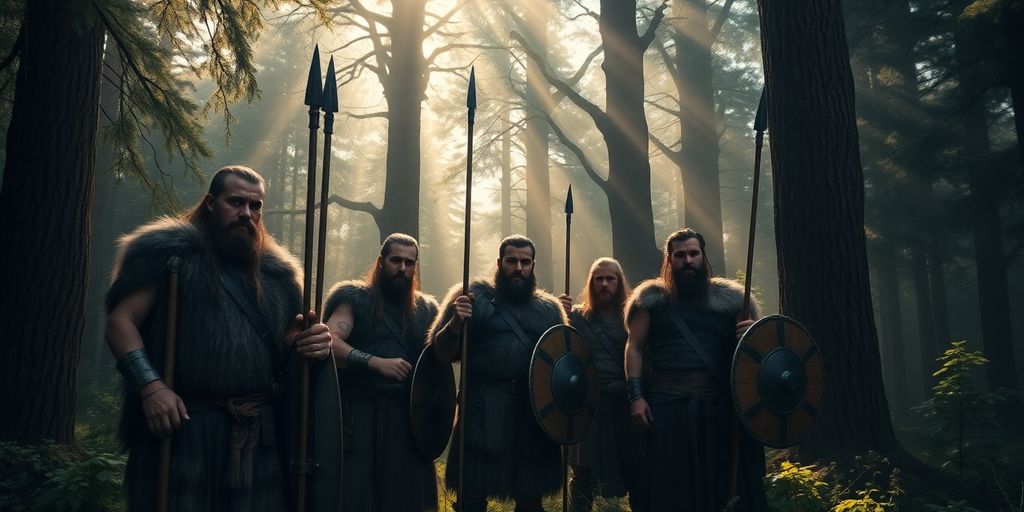The Twin Tales of Castor and Pollux

Castor and Pollux, the legendary twins from Greek and Roman mythology, are famous for their unique parentage and adventures. Known as the Dioscuri, these brothers are celebrated for their bravery and loyalty to each other. Their story is filled with daring exploits, divine interventions, and a bond so strong it reached the stars. From rescuing their sister Helen to joining the quest for the Golden Fleece, their tales are both thrilling and touching. Let’s dive into their myth and see why these twins are still remembered today.
Key Takeaways
- Castor and Pollux were twin brothers with different fathers, making their story unique in mythology.
- They played a key role in the rescue of their sister Helen, showcasing their bravery and family loyalty.
- The twins were part of famous mythological adventures like the Calydonian Boar Hunt and the quest for the Golden Fleece.
- Pollux’s love for Castor was so profound that he shared his immortality, leading to their transformation into the Gemini constellation.
- Castor and Pollux are revered as protectors of sailors and are associated with the constellation Gemini.
The Mythical Origins of Castor and Pollux

Leda and the Swan: A Divine Encounter
In the world of Greek mythology, the tale of Castor and Pollux begins with their mother, Leda. She was a Spartan queen, known for her beauty, which caught the eye of Zeus himself. One day, as Leda strolled along the Eurotas River, she encountered a swan struggling to escape an eagle. The swan, which was actually Zeus in disguise, charmed Leda with its elegance. This unusual encounter led to a night of dual unions; Leda was with both Zeus and her husband, King Tyndareus, on the same night.
The Birth from Two Eggs
The result of these unions was quite extraordinary. Leda laid two eggs, from which four children emerged. Among them were the twins, Castor and Pollux. This birth from eggs is a unique aspect of their mythology, highlighting the divine and unusual nature of their origins. Castor was considered the son of Tyndareus, making him mortal, while Pollux was the offspring of Zeus, granting him immortality.
The Dual Paternity of the Twins
The concept of dual paternity plays a significant role in the story of Castor and Pollux. While they shared the same mother, their different fathers set them apart in terms of mortality. Pollux, being the son of Zeus, was immortal, whereas Castor, being the child of Tyndareus, was not. This distinction between the brothers is central to their myth, reflecting themes of brotherhood and the contrast between life and death. Despite their different fathers, the bond between Castor and Pollux was unbreakable, showcasing their loyalty and unity as the Dioscuri.
Adventures and Exploits of the Dioscuri

The Rescue of Helen from Theseus
Castor and Pollux, the famed twin brothers, embarked on a daring mission to rescue their sister Helen from the clutches of Theseus. Helen had been abducted by Theseus and taken to Athens, sparking outrage in Sparta. The twins, known for their bravery and loyalty, set out to bring her back. They infiltrated Athens, employing both cunning and strength, and successfully retrieved Helen, restoring her to her rightful place in Sparta. This exploit not only showcased their heroism but also solidified their reputation as protectors of their family.
The Calydonian Boar Hunt
Among their many adventures, the Calydonian Boar Hunt stands out as a testament to their prowess. The king of Calydon had offended Artemis, who in retaliation sent a monstrous boar to ravage the land. Castor and Pollux joined a band of heroes, including Atalanta and Meleager, to slay the beast. Armed with their skills in horsemanship and combat, the twins played a crucial role in the hunt, demonstrating their unmatched abilities and teamwork. The successful hunt not only brought them glory but also strengthened their bonds with other legendary heroes.
The Quest for the Golden Fleece
The Dioscuri’s adventures extended to the legendary Quest for the Golden Fleece. As part of the Argonauts, they sailed with Jason on the Argo, facing numerous challenges on their journey. Their contributions were invaluable, from navigating treacherous waters to battling fierce enemies.
- They helped calm a storm sent by Zeus.
- Assisted in the defeat of the harpies tormenting Phineas.
- Engaged in a boxing match where Pollux defeated the formidable King Amycus.
Their participation in this epic quest not only highlighted their bravery but also cemented their status as key figures in Greek mythology.
In the tapestry of myth, the Dioscuri’s tales of adventure and courage are woven with threads of loyalty, skill, and divine favor. Their exploits continue to inspire, reminding us of the timeless allure of heroism.
The Mortal and Immortal Bond
The Death of Castor and Pollux’s Grief
So, Castor and Pollux were super close. Like, they did everything together. But then, tragedy struck. Castor, being mortal, was killed in a fight. Pollux was devastated. His brother was gone, and he couldn’t handle it. He loved his brother so much that he didn’t want to live without him. Imagine losing your other half like that.
Zeus’s Intervention and the Shared Immortality
Pollux, being the son of Zeus, was immortal, unlike Castor. Pollux begged his dad to let him die too, so he could be with Castor. But Zeus had another idea. He offered them a deal: they’d share Pollux’s immortality. This meant they could spend half their time in the heavens and the other half in the underworld. It’s like they got to be together forever, just not all the time.
The Symbolism of the Gemini Constellation
This whole story of shared immortality is why they became the constellation Gemini. The twins are up in the sky, a symbol of brotherly love and sacrifice. The constellation is visible for part of the year, just like their myth says they spend half their time above and half below. It’s a reminder of their bond, even in the stars.
Cultural Significance and Legacy
Patrons of Sailors and Horsemanship
Castor and Pollux, often referred to as the Dioscuri, have long been seen as protectors of sailors and masters of horsemanship. Sailors across the ancient Mediterranean would often pray to these twins for safe passage across the treacherous seas. Their presence was believed to calm storms and guide ships safely to harbor. In equestrian circles, the twins were celebrated for their skills in taming and riding horses, a legacy that has cemented their place in mythology as patrons of both sea and land travelers.
Representation in Art and Literature
Throughout history, the tales of Castor and Pollux have inspired countless works of art and literature. From ancient sculptures to Renaissance paintings, their story has been depicted in various forms, showcasing the enduring fascination with their myth. They appear in epic poems and are referenced by playwrights, symbolizing themes of brotherhood and sacrifice. Their influence extends beyond visual arts, finding a place in the literary canon as symbols of duality and unity.
The Dioscuri in Roman Mythology
In Roman culture, the twins were not just mythological figures but also part of the religious fabric of society. Known as the Dioscuri, they were worshipped as gods who could bring victory in battle and were often invoked in military contexts. The Romans celebrated them with festivals and erected temples in their honor, highlighting their importance in Roman religion. Their legacy is a testament to their lasting impact, bridging Greek and Roman mythologies and continuing to captivate the imagination of people through the ages.
The legacy of Castor and Pollux is as enduring as the stars that bear their names, shining brightly in the night sky as a reminder of their timeless story.
The Complex Parentage and Identity
The Role of Tyndareus and Zeus
The tale of Castor and Pollux is a fascinating blend of myth and mystery, largely due to their unique parentage. Leda, their mother, was married to King Tyndareus of Sparta. However, the story takes a twist with the involvement of Zeus, the king of the gods. According to legend, Zeus transformed into a swan and seduced Leda, resulting in the birth of these legendary twins. This divine encounter led to the birth of two sets of twins from two eggs, with Castor being the mortal son of Tyndareus and Pollux the immortal offspring of Zeus. This dual paternity is a rare case of heteropaternal superfecundation, a concept that adds layers to their mythological narrative.
The Inseparable Half-Brothers
Despite their different fathers, Castor and Pollux were inseparable from birth. They were often referred to as the Dioscuri, which means "sons of Zeus," highlighting their shared divine heritage. Their bond was so strong that they were rarely spoken of individually. This unity is a central theme in their myth, symbolizing the balance between mortality and immortality. The twins were known for their adventures and heroic deeds, always standing by each other’s side, whether in battles or quests. This unbreakable bond is what made them legendary figures in Greek mythology.
Names and Titles Across Cultures
The names and titles of Castor and Pollux have evolved over time, influenced by various languages and cultures. Originally known as Kastor and Polydeukes in Greek, their names changed as they were adopted into Roman mythology, becoming Castor and Pollux. They were also called the Gemini, meaning "twins," a name that has persisted through the ages. In addition to the Dioscuri, they were sometimes referred to as the Tyndaridae, linking them to their mortal lineage through Tyndareus. This variety of names reflects their widespread influence and the enduring fascination with their story across different cultures and eras.
The story of Castor and Pollux is not just about their adventures but also about their complex identities, which bridge the mortal and the divine. Their tale is a reminder of the intricate tapestry of mythology, where gods and humans often share intertwined destinies.
The Eternal Presence in the Night Sky
The Transformation into Stars
Castor and Pollux, the legendary twins, were immortalized in the night sky as the constellation Gemini. Zeus, in his compassion, granted them this celestial honor after the tragic death of Castor. While Pollux was immortal, Castor was not. To keep them together, Zeus placed them among the stars, ensuring their bond was eternal. The constellation Gemini shines brightly, a testament to their enduring brotherhood.
The Seasonal Visibility of Gemini
Gemini, with its twin stars, is most visible in the winter sky. Starting from late November, it climbs higher each night, reaching its peak in February. By April, it begins to fade into the twilight. This seasonal dance is a reminder of the cycle of life and the enduring presence of these mythical twins. For stargazers, spotting Gemini is a winter tradition, a chance to connect with the stories of old.
Astrological Interpretations of Castor and Pollux
In astrology, Gemini is often associated with duality and communication. The twins, Castor and Pollux, represent the dual nature of existence — the mortal and the divine. Those born under Gemini are thought to be adaptable and curious, embodying the spirit of the twins. Their influence is seen in the mutable nature of the sign, symbolizing change and versatility. Whether you believe in astrology or not, the stories of Castor and Pollux add a layer of intrigue to the stars that bear their name.
As you gaze upon the stars, remember that these celestial twins are more than just points of light; they are a bridge between myth and reality, a reminder of the stories that have shaped our understanding of the cosmos.
Conclusion
So, there you have it, the story of Castor and Pollux, the twins who were more than just brothers. Their tale is a mix of adventure, love, and a bit of divine intervention. From their daring rescue missions to their celestial transformation, these two have left a mark on mythology that’s hard to forget. Whether they were sailing the seas or riding horses, their bond was unbreakable. And even in the stars, they remind us of the power of brotherly love and the lengths one might go to keep family close. It’s a story that, despite its age, still resonates today, showing that some things, like love and loyalty, are truly timeless.
Frequently Asked Questions
Who were Castor and Pollux?
Castor and Pollux were twin brothers from Greek and Roman mythology, known for their strong bond and heroic adventures. They had different fathers because their mother, Leda, was visited by Zeus, who took the form of a swan.
What is the story of Castor and Pollux?
The story of Castor and Pollux has many versions. They were known for rescuing their sister Helen and joining the hunt for the Calydonian Boar and the quest for the Golden Fleece. Their bond was so strong that when Castor died, Pollux asked Zeus to share his immortality with him.
Why are Castor and Pollux associated with the Gemini constellation?
Castor and Pollux are associated with the Gemini constellation because, after Castor’s death, Zeus placed them in the sky as stars. This was a symbol of their eternal brotherly love and unity.
What roles did Castor and Pollux play in mythology?
In mythology, Castor was known for his skills with horses, while Pollux was a great boxer. Together, they were patrons of sailors and were often called upon for protection during sea voyages.
How did Castor and Pollux become stars?
When Castor died, Pollux was heartbroken and asked Zeus to let them stay together. Zeus granted this wish by placing them in the sky as the constellation Gemini, allowing them to be together forever.
What is the cultural significance of Castor and Pollux?
Castor and Pollux are important figures in mythology, representing themes of brotherhood and loyalty. They are also seen as protectors of sailors and are celebrated in various cultural stories and artworks.







Responses